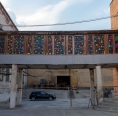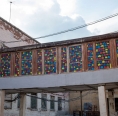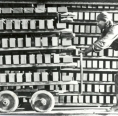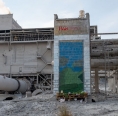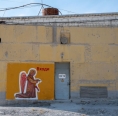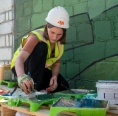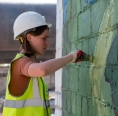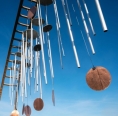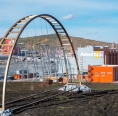-
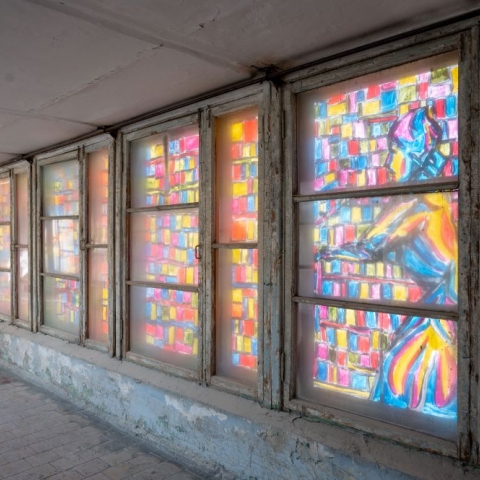
PRODUCING INSPIRATION
-
Address:
-
Partners:
Projects by theater set design students of the Russian Institute of Theater Arts (GITIS) have become new interface points for manufacture and modern art.
Three students – Yelizaveta Yermakova, Anastasia Kun and Valentina Nikolaichuk – took an internship at the Satka production site of Magnezit Group and, working under the guidance of their mentor Dmitry Butkevich added new projects in public art (art presented in an urban environment or in public spaces) and land art (art presented on the terrain) styles to the industrial landscape of the fireproof giant.
Paintings with a twist
Yelizaveta Yermakova, a student of Nikolai Simonov’s class, painted the windows in the link building (between the finished goods warehouse of Section No. 2 of the Manufacturing Department and the building of Quality Control and Testing Department and the Engineering, Design and Operations Department). A painting covering 35 sq. m in total spans the entire length of the link building (14 m), looking like a bright-colored mosaic from a distance. Close up, you can see a myriad of colored “tiles” that “sprawl” into tiny houses. And in the background – a woman pushing a wagon. People who are familiar with Magnezit’s history and have been to the corporate museum at least once would recognize in the woman someone who used to work here – a hauler. Before this profession became obsolete, haulers were mostly women. They would push wagons with molded refractory material along the rail tracks towards chamber furnace dryers. This process is captured in a 1930s photograph kept at Magnezit Museum. It was that snapshot along with the colorful buildings in the old part of Satka that inspired Yelizaveta Yermakova.
“I saw the photo in the spring when we went to Satka before our internship and visited the museum to learn more about operations of Magnezit Group,” she said. “And when they showed me the place where I was to work, I decided to use this photo to create a bright-colored painting with the main rainbow colors in contrast with the sandy shades of the plant building.” The “tiles” in the woman’s wagon are falling apart gradually and transform into colorful houses, growing into a town. Besides, since this is painted on windows, there is a surprise for those inside the link building – the reverse side of the stained-glass painting. The interesting thing about this art form is this unexpected effect on the reverse side of the painting, plus the glass is a good material, which is comfortable to work with.
You can feel here the dynamic created by the painter, not only with the idea and artistic techniques showing the growth and transformation, but also with a theatrical effect. According to Yelizaveta, it is in the illusion of movement – the woman seems to be moving through the tunnel.
“Our practical work intersects with theater history in one way or another. We do projects outside the university and the theater, but they are related to the art of theater. During such internship, every student may prove themselves in something new, for example, they may create a picture or a piece of public art instead of just working as a decorator,” says the author of the mosaic stained-glass window.
Thanks to this project, Yelizaveta gained new experience. It wasn’t just the first time she had did a job of such magnitude, but the first time she worked at height, for which she took a special course and received a certificate of a high rigger.
“The first day was hard because I’m afraid of heights,” the girl recounts. “But I got used to it pretty quickly, especially since everyone encouraged me, helped me in everything, supported me, and even clapped for me when I got down. It was a great pleasure to work in such an environment, with sympathetic and friendly people. I did most of the work in the shade, which made me more comfortable (I was lucky with this, because the weather was very hot), plus this part of the plant was not dusty. It was nice that it was a go-through zone and I was able to communicate with Magnezit staff. I’m glad that people were interested in my work and understood the idea right away.”
Series with and without angels
“Drawing at an active production facility is a unique opportunity,” says Valentina Nikolaichuk, a student of GITIS, who completed a series of works that begun last year. “The area of the plant is a most interesting site, because it’s not a city where you can create street art anywhere. Here, ideas come from the nature of production. You come in, you realize what this place is and then you work accordingly. For me, it’s a very interesting process.
Valentina began her work last year by creating a mural in the CCP area (an image with angels and the inscription “Don’t Look Back”) and began another work at the PPD. And this year, she completed the project.
“The idea of doing a series of murals was born partly by accident. When I came to Magnezit last year, I didn’t know what I was going to do, because my previous idea didn’t work out for technical reasons. In my search for a place to work, I settled on the CCP. The idea came by surprise: I was standing in front of the building whose wall was to be painted, with various pipes stretching next to it; there was a huge pipe behind me, and I felt scared to turn around and look at it. At that moment I thought of a story I knew from literature (the parable of Lot’s wife), where the character was afraid to look back, to turn around and face his fear. That’s how the idea of the first mural was born. I wanted to do the other two murals in the context of the first one and complete the series, so that the “murals” would form a little story.
The plot sequence of Valentina’s work is as follows: the first “mural” says “Come in!”, the second one says “Walk straight ahead!” and the third says “Don’t look back!”
“This came out of personal experiences,” the author explains. “When you’ve made a mistake in the past or lost a loved one, you want to look back, and it really hurts. And my story is about the future, about moving forward without looking back.
Before her visit to Satka, Valentina had never done any wall painting, so Magnezit inspired her to do art of a different kind.
“I want to work more in that direction. It’s hard to explain it interests me. When you take a brush like this,” - says Valentina and shows the size of 10-15 cm, “and you take an unprepared wall and create something... Art is always a thrill, especially art at an industrial facility. It’s like watching a golf ball falling into the hole. In a city, you can make a sketch for a painting that could be made on any wall, anywhere, but an idea born at an industrial facility will only be realized there, in a particular place. It’s like puzzles, only on the ground. And, of course, it’s excitement and adrenaline!
The Chimes
That’s what Anastasia Kuhn called her work. Her idea has come to life as an interesting metal structure: a metal arch 3 meters high with aluminum wind chimes and metal disks attached to it (Aluminum has a pleasant, high sound; this material doesn't need coating, which could muffle the sound, and it is resistant to environmental effects). Metal, wind, an art concept, an industrial site and the Russian Magnezit – all this came together in a project of a student of the Russian Institute of Theatre Arts (GITIS).
“I think the project has worked out well! We succeeded largely due to concerted effort of everyone involved in the project and, despite various issues, the result is true to original idea”, Anastasia says. - “Finding the location took us a long time as we needed the arch to look well from any point and fit in with the surroundings. Eventually, we decided to install it close to the Russian Magnezit viewing platform so that the view included the industrial part and its natural surroundings. The arch was placed at an angle that exposed it to wind almost all the time, making the chimes ring. I give my thanks to everyone who worked on this project for doing an excellent job, with precision and high quality. I am glad that a lot of time and care was invested into every detail, material of the structure, the paint work for it, the selection of the location, and the process of installation. Everything is important! It was an incredibly interesting experience: working with new materials, remarkable people, powerful industrial facilities and a branch of art that was new to me – land art, where the object created interacts with nature, with wind.”
This is the first time Anastasia is doing land art (art on the ground) and she literally fell in love with it.
“It’s great when the art you create interacts with nature, with its surroundings; in my case, the chimes will ring in the wind. Such objects of art are more difficult to make than static ones, such as a sculpture, and it is more interesting. Outdoor sites allow realizing unique ideas, and modern technology gives a lot of opportunities for such creativity, and allows you to do it well.
Source: Magnezitovets. Photo by Vasily Maksimov, Anna Filippova, the Magnezit Museum.
-
26.08 - 26.08
DIARY OF THE THIRD INDUSTRIAL BIENNALE
-
28.11 - 28.11
MY SATKA FESTIVAL WINS THE CONTEST OF CORPORATE VOLUNTEER PROJECTS
-
13.10 - 15.10
COOPERATION WITH VGIBL NAMED AFTER M.I. RUDOMINO

